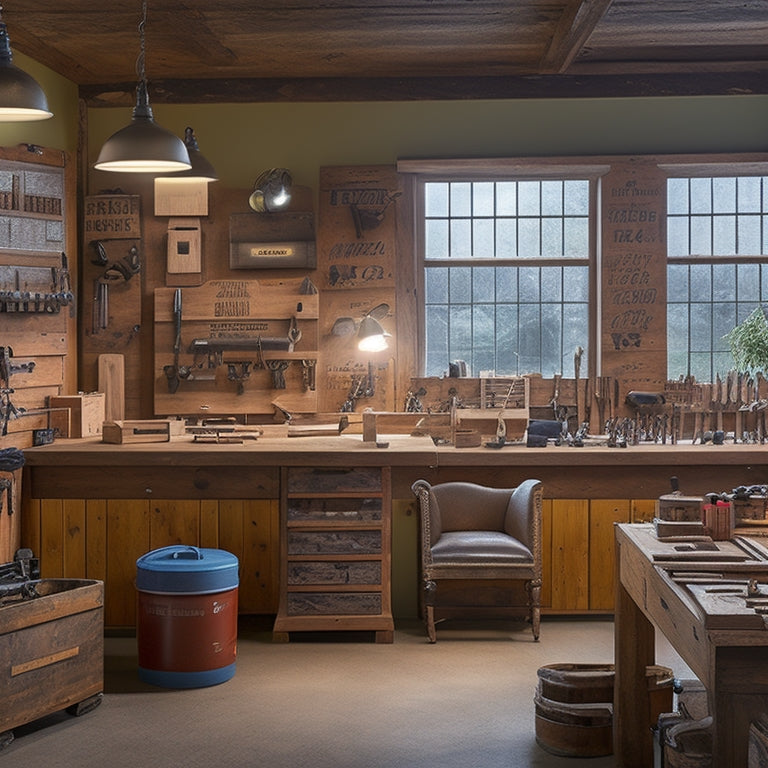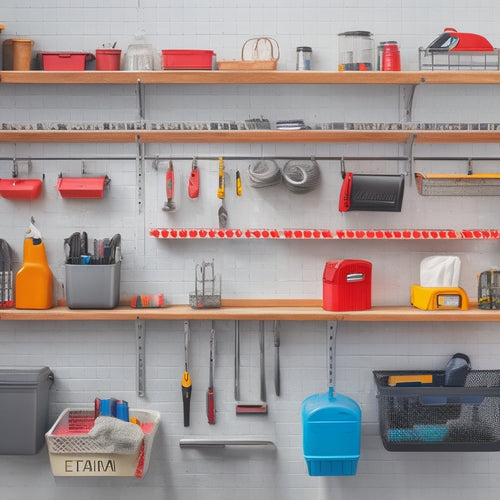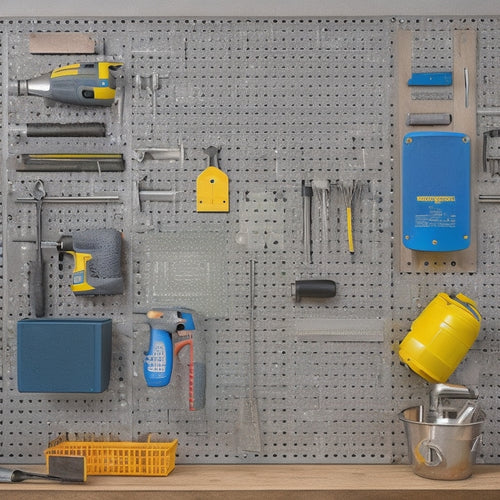
Revamp Your Woodworking Space for Optimal Efficiency
Share
I've redesigned my woodworking space to maximize efficiency, prioritizing ergonomic workbenches, ample natural light, and flexible layouts for peak workflow. Rubber flooring and strategically placed dust collection coils provide a comfortable and healthy environment. My electrical setup boasts dedicated breaker boxes, ceiling-mounted power reels, and LED task lighting for excellent visibility. Organized storage zones, multitasking hubs, and repurposed cabinets keep tools and materials within easy reach. By optimizing my workspace, I've increased productivity and reduced fatigue. Now, I'm ready to fine-tune my workflow configuration to tackle even the most complex projects with precision.
Key Takeaways
• Prioritize ergonomic workbenches and essential ventilation solutions to create a healthy and comfortable working environment.
• Opt for a flexible layout with in-floor dust collection and trench grates to maximize space and optimize workflow.
• Invest in a reliable dust collection system with strategically placed coils and a multitasking hub for efficient tool access.
• Design the workspace with flexibility and adaptability in mind, planning for future expansion and easy modification of the layout.
• Position tools and machinery strategically to minimize walking distances and maximize productivity, streamlining workflow and reducing waste.
Shop Design and Essentials
When designing my woodworking space, I prioritize a well-planned layout that incorporates essential elements to guarantee a comfortable, efficient, and safe working environment.
I focus on creating an ergonomic workspace by incorporating ergonomic workbenches that promote good posture and reduce fatigue. Essential ventilation solutions are also vital to remove dust and fumes, ensuring a healthy working environment.
I make sure ample natural light through windows and skylights, reducing the need for artificial lighting. A flexible layout with options like in-floor dust collection and trench grates allows me to maximize space and optimize workflow.
Flooring and Dust Solutions
Incorporating the right flooring and dust collection systems is essential for maintaining a safe, efficient, and healthy woodworking environment. As I design my ideal woodworking space, I prioritize these components to guarantee a smooth workflow and minimize hazards. Here are some key considerations:
-
Flooring: I opt for rubber flooring, which provides cushioning, reduces fatigue, and is easy to clean. It's a game-changer for my joints and overall comfort.
-
Dust collection coils: I invest in a reliable dust collection system with strategically placed coils to minimize dust accumulation and reduce the risk of explosions.
-
Easy maintenance: I design the system for easy rearrangement and maintenance, ensuring that cleaning and replacing dust collection coils is a breeze.
- Radiant floor heating: I consider adding radiant floor heating for added comfort and warmth during those long workshop sessions.
Electrical Setup and Lighting
As I design my ideal woodworking space, I prioritize a robust electrical setup and strategic lighting plan to guarantee safe, efficient, and accurate workflow.
To achieve this, I'm installing a dedicated breaker box with additional outlets for convenience. I'll run 110v and 220v power across the ceiling to keep power cords off the floor, ensuring a clutter-free workspace.
LED overhead lighting and task lighting will provide excellent visibility, while pull-down power reels in the ceiling will grant easy access to hand tools.
Ceiling power management will allow me to allocate power efficiently, and LED task lighting will illuminate specific work areas. With numerous electrical outlets on walls and ceiling, I'll have ample power supply to support my woodworking activities.
Storage and Organization Systems
By allocating sufficient wall space for hanging tools, jigs, and accessories, I'm creating a well-organized workspace that boosts productivity and reduces fatigue. A well-designed storage and organization system is essential for peak efficiency. I'm incorporating custom storage solutions, such as solid wood or plywood walls, to maximize storage capacity.
Here are some innovative organization strategies I'm implementing:
-
Dedicated areas: Designating specific zones for wood storage, air compressors, and dust collectors to keep the workspace clutter-free.
-
Center island: Combining outfeed, workbench, and hardware drawers to create a multitasking hub.
-
Soundproofed bumpout: Creating a noise-reducing enclosure for the dust collector and compressor.
- Repurposed cabinets: Utilizing old kitchen cabinets and pantry cabinets for easy access and storage.
These custom storage and innovative organization systems will revolutionize my woodworking space, allowing me to work smarter, not harder.
Long-Term Planning Strategies
I'm designing my woodworking space with flexibility and adaptability in mind, recognizing that my tool collection and workflows will inevitably evolve over time.
I'm planning for future expansion, anticipating the need for additional space to accommodate new tools and workflows. To maximize space utilization, I'm opting for a larger shop size than the standard 16x20, ensuring I've room to grow.
I'm also incorporating features like high ceilings and rafters to create a spacious feel. By designing my shop with flexibility in mind, I'll be able to easily modify and revamp my layout as needed, without having to start from scratch.
This forward-thinking approach will allow me to adapt to changing tool requirements and workflows, ensuring my shop remains efficient and effective for years to come.
Efficient Workspace Layout
With a flexible and adaptable shop design in place, I'm now focusing on creating an efficient workspace layout that optimizes tool placement, workflow, and storage to maximize productivity.
A well-designed layout is essential for streamlining my woodworking process and reducing fatigue. To achieve this, I'm incorporating ergonomic workstations that promote comfortable working conditions and reduce strain on my body.
Here are some key considerations for my efficient workspace layout:
-
Tool placement: Strategically placing tools within easy reach to minimize walking distances and reduce workflow disruptions.
-
Space utilization: Maximizing floor space by using wall-mounted storage and mobile workstations to create a flexible and adaptable work environment.
-
Workflow optimization: Designing the layout to facilitate a logical workflow, reducing congestion and increasing productivity.
- Storage organization: Implementing a storage system that keeps frequently used items accessible and less frequently used items stored out of the way.
Optimal Workflow Configuration
To configure an ideal workflow, I prioritize tasks that require heavy machinery or large workpieces, positioning them in a sequence that minimizes backtracking and maximizes efficiency. This strategic tool placement enables me to work smarter, not harder.
I group similar tasks together, ensuring a logical flow from one process to the next. Workflow optimization is key, and I achieve this by identifying bottlenecks and streamlining my process. By doing so, I reduce waste, increase productivity, and enhance overall workflow efficiency.
A well-planned workflow configuration allows me to focus on the task at hand, rather than spending time maneuvering through a cluttered and inefficient workspace. With an optimized workflow, I can tackle complex woodworking projects with confidence and precision.
Frequently Asked Questions
How Do I Prevent Electrical Overload With Multiple Power Tools?
Like a master conductor, I orchestrate my power tools, ensuring electrical harmony by distributing power across multiple circuits, leveraging circuit breakers, and strategically planning power distribution to prevent overload and keep my workshop humming in perfect sync.
Can I Convert My Garage Into a Woodworking Shop?
I'm converting my garage into a woodworking shop, carefully designing a floor plan that accommodates my tools and workflow, while exploring insulation options like foam board or reflective insulation to maintain a comfortable working temperature.
What Safety Features Should I Prioritize in My Shop Design?
"When it rains, it pours," and safety should be my top priority. I'll prioritize Personal Protection by incorporating features like dust collection systems, fire extinguishers, and first aid kits, while ensuring Emergency Exits are well-lit and easily accessible.
How Often Should I Maintain and Clean My Dust Collection System?
I maintain my dust collection system daily by cleaning filters and inspecting airflow, ensuring peak performance and preventing clogs, and perform deep cleaning every quarter to optimize airflow and extend system lifespan.
Are There Any Local Building Codes I Need to Consider for My Shop?
Before breaking ground on my shop, I'll research local zoning regulations and permit requirements to guarantee compliance, avoiding costly surprises and potential shutdowns.
Related Posts
-

Small Storage Bins to Maximize Shelf Space
When maximizing shelf space, you want to make the most of every inch. Small storage bins are the answer, but choosing...
-

3 Simple Steps to a Garage Tool Wall You'll Love
To create a garage tool wall you'll love, start by planning the space, taking inventory of your tools, and measuring ...
-

How to Hang a Pegboard in 5 Easy Steps
You'll hang a pegboard in 5 easy steps by first preparing the wall, ensuring it's sturdy and free of obstructions. Ne...


